【人工智能学习之手写数字识别K-means聚类算法的Python 实现示例】
1 前期准备
1.1 所需模块
from torch import nn
import torch
from torchvision import datasets,transforms
from torch.utils.data import DataLoader
import matplotlib.pyplot as plt
# matplotlib版本不同需要调整
import matplotlib
matplotlib.use('TkAgg')
DEVICE = torch.device("cuda" if torch.cuda.is_available() else "cpu")
报错的话可以参考:TypeError: int() argument must be a string, a bytes-like object or a number, not ‘KeyboardModifier‘
1.2 下载数据集
直接下载手写数字的训练集
# 下载训练集
train_data = datasets.MNIST("data/",train=True,transform=transforms.ToTensor(),download=True)
train_loader = DataLoader(train_data,batch_size=600,shuffle=True)
1.3 全连接网络
因为手写数字识别很简单,直接使用全连接网络即可。
不过我们可以使用一些比较新的技术比如Mish()。
感兴趣的朋友也可以使用Relu()或者其它激活函数尝试,效果不是特别好,聚类比较随意。
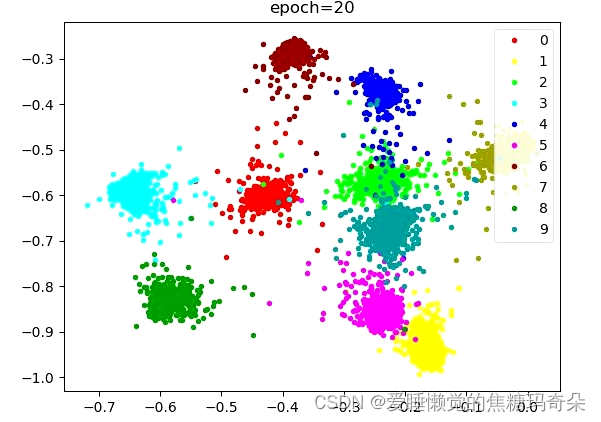
class Net(nn.Module):
def __init__(self):
super().__init__()
self.fc1 = nn.Sequential(
nn.Linear(28*28*1,512,bias=False),
nn.BatchNorm1d(512),
nn.Mish(),
nn.Linear(512,256,bias=False),
nn.BatchNorm1d(256),
nn.Mish(),
nn.Linear(256,128,bias=False),
nn.BatchNorm1d(128),
nn.Mish(),
nn.Linear(128,2),
)
self.fc2 = nn.Sequential(
nn.Linear(2,10),
)
def forward(self,x):
feature = self.fc1(x)
cls_out = self.fc2(feature)
return feature,cls_out
1.4 可视化2维特征
将特征分类可视化
# 可视化2维特征
def visualize(feature,labels,epoch):
plt.ion()
c = ["#ff0000","#ffff00","#00ff00","#00ffff","#0000ff",
"#ff00ff","#990000","#999900","#009900","#009999"]
plt.clf()
for i in range(10):
plt.plot(feature[labels==i,0],feature[labels==i,1],".",c=c[i])
plt.legend(["0","1","2","3","4","5","6","7","8","9"],loc="upper right")
plt.title("epoch=%d" % epoch)
plt.savefig("images02/epoch=%d.jpg"%epoch)
plt.draw()
plt.pause(0.001)
2 多分类交叉熵损失函数
我们先使用多分类交叉熵损失函数,它可以衡量两个概率分布之间的距离
在深度学习中:概率分布=特征分布
if __name__ == '__main__':
net = Net().to(DEVICE)
loss_func = nn.CrossEntropyLoss()
opt = torch.optim.Adam(net.parameters())
EPOCH = 10000
for epoch in range(EPOCH):
feature_loader = []
labels_loader = []
for i,(img,label) in enumerate(train_loader):
img = img.reshape(-1,28*28).to(DEVICE)
label_ = label.to(DEVICE)
feature,cls_out = net(img)
loss = loss_func(cls_out,label_)
opt.zero_grad()
loss.backward()
opt.step()
feature_loader.append(feature)
labels_loader.append(label)
if i%10==0:
print(f"epoch:{epoch},batch:{i},loss:{loss.item()}")
features = torch.cat(feature_loader,0)
labels = torch.cat(labels_loader)
visualize(features.data.cpu().numpy(),labels.data.cpu().numpy(),epoch=epoch)
可以发现刚开始分布还比较混乱:

随着损失下降逐渐开始聚合。
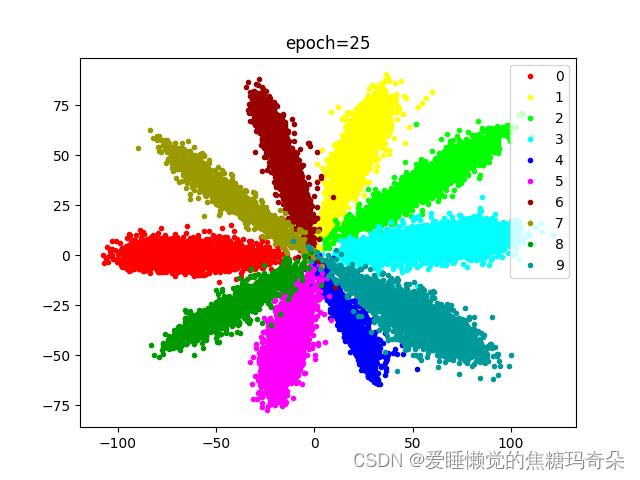
可以看到训练到八十次过后效果已经非常明显了。
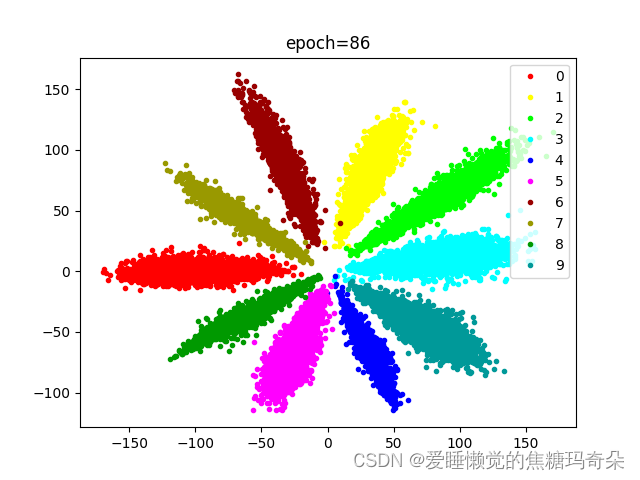
那么可不可以更优化一些呢,比如下图这样?
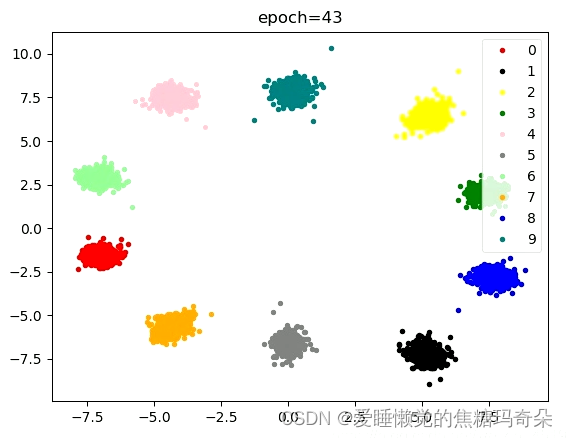
这就需要确定一个中心点让网络向那个方向收敛。
3 CenterLoss中心点损失

理解案例:
import torch
# 拟定一些参数
data = torch.Tensor([[3,4],[5,6],[7,8],[9,8],[6,5]])
label = torch.Tensor([0,0,1,0,1])
center = torch.Tensor([[1,1],[2,2]])
# 用label索引center进行扩充[[1,1],[1,1],[2,2],[1,1],[2,2]]
center_exp = center.index_select(dim=0,index=label.long())
print(center_exp)
# 统计label的类别
count = torch.histc(label,bins=2,min=0,max=1)
print(count)
# 用label索引count获取每部分的权重
count_exp = count.index_select(dim=0,index=label.long())
print(count_exp)
# 中心点公式
center_loss = torch.sum(torch.div(torch.sqrt(torch.sum(torch.pow(data-center_exp,2),dim=1)),count_exp))
print(center_loss)
中心点损失代码:
class CenterLoss(nn.Module):
def __init__(self,cls_num,feature_num):
super().__init__()
self.cls_num = cls_num
self.center = nn.Parameter(torch.randn(cls_num,feature_num))
def forward(self,xs,ys):
center_exp = self.center.index_select(dim=0, index=ys.long())
count = torch.histc(ys, bins=self.cls_num, min=0, max=self.cls_num-1)
count_exp = count.index_select(dim=0, index=ys.long())
center_loss = torch.sum(torch.div(torch.sqrt(torch.sum(torch.pow(xs - center_exp, 2), dim=1)), count_exp))
return center_loss
神经网络伪代码:
class MainNet(nn.Module):
def __init__(self):
super().__init__()
self.hidden_layer = nn.Sequential(
nn.Linear(784,120),
nn.Mish(),
nn.Linear(120,2)
)
self.output_layer = nn.Sequential(
nn.Linear(2,10)
)
self.center_loss_layer = CenterLoss(10,2)
self.crossEntropyLoss = nn.CrossEntropyLoss()
def forward(self,xs):
features = self.hidden_layer(xs)
outputs = self.output_layer(features)
return features,outputs
def getLoss(self,outputs,features,labels):
loss_cls = self.crossEntropyLoss(outputs,labels)
loss_center = self.center_loss_layer(features,labels)
loss = loss_cls + loss_center
return loss
当然,网络也可以换成卷积,效果会更好一些。
卷积网络代码:
class VGGnet_pro(nn.Module):
def __init__(self):
super().__init__()
self.center_loss_layer = CenterLoss(10, 2)
self.crossEntropyLoss = nn.CrossEntropyLoss()
self.conv_res = nn.Sequential(
nn.Conv2d(64, 64, 1, 2, 0, bias=False),
nn.BatchNorm2d(64),
)
self.conv_layer1 = nn.Sequential(
nn.Conv2d(1, 64, 7, 2, 3, bias=False),
nn.BatchNorm2d(64),
nn.Mish(),
nn.MaxPool2d(3, 2, 1)
)
self.conv_layer2 = nn.Sequential(
nn.Conv2d(64, 128, 1, 1, 0, bias=False),
nn.BatchNorm2d(128),
nn.Mish(),
nn.Conv2d(128, 128, 3, 1, 1, groups=128, bias=False),
nn.BatchNorm2d(128),
nn.Mish(),
nn.Conv2d(128, 64, 1, 1, 0, bias=False),
nn.BatchNorm2d(64),
nn.Mish(),
)
self.conv_layer3 = nn.Sequential(
nn.Conv2d(64, 64, 3, 2, 1, bias=False),
nn.BatchNorm2d(64),
nn.Mish(),
nn.Conv2d(64, 64, 3, 1, 1, bias=False),
nn.BatchNorm2d(64),
)
self.conv_layer4 = nn.Sequential(
nn.Conv2d(64, 64, 3, 1, 1, bias=False),
nn.BatchNorm2d(64),
nn.Mish(),
nn.Conv2d(64, 64, 3, 1, 1, bias=False),
nn.BatchNorm2d(64),
nn.Mish(),
nn.Conv2d(64, 64, 3, 1, 1, bias=False),
nn.BatchNorm2d(64),
nn.Mish(),
nn.AvgPool2d(4, 1)
)
self.classifier_xy = nn.Sequential(
nn.Linear(64, 2)
)
self.classifier = nn.Sequential(
nn.Linear(2, 10)
)
def forward(self, x):
x = self.conv_layer1(x)
res = self.conv_res(x)
x = self.conv_layer2(x)
x = self.conv_layer3(x)
x = F.mish(x + res)
x = self.conv_layer4(x)
x = x.reshape(x.shape[0], -1)
feature = self.classifier_xy(x)
cls_out = self.classifier(feature)
return feature, cls_out
def getLoss(self, outputs, features, labels):
loss_cls = self.crossEntropyLoss(outputs, labels)
loss_center = self.center_loss_layer(features, labels)
loss = loss_cls * 0.999 + loss_center * 0.001
return loss
训练代码中只需要修改损失函数即可:
loss = net.getLoss(cls_out, feature, label_)
4 ArcSoftmax损失
softmax函数大家都很熟悉,在此就不赘述了,不清楚的可以简单看一下下图。
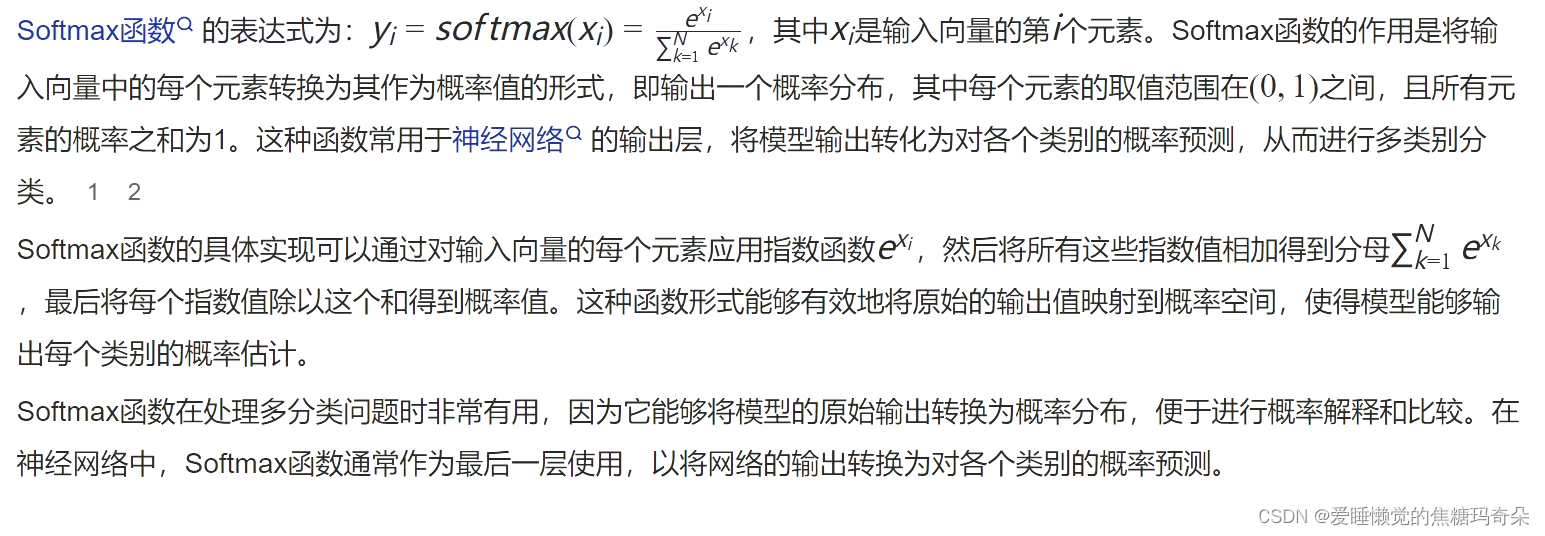
Arc-SoftmaxLoss = Arc-Softmax + NLLLoss。
softmax 是通过角度分类的,Arc-Softmax 加宽了角度间的分界线,从而达到加大类间距的目的。
Arc-Softmax(加大 θ 角度)公式:

Arc-Softmax代码:
class ArcSoftmax(nn.Module):
def __init__(self, feature_dim, cls_dim=10):
super().__init__()
self.w = nn.Parameter(torch.randn(feature_dim, cls_dim))
def forward(self, feature, m=0.5, s=10):
x = F.normalize(feature, dim=1)
w = F.normalize(self.w, dim=0)
cos = torch.matmul(x, w) / 10 #防止梯度爆炸 /10
a = torch.acos(cos)
top = torch.exp(s * torch.cos(a + m))
down = torch.sum(torch.exp(s * torch.cos(a)), dim=1, keepdim=True) - torch.exp(s * torch.cos(a)) + top
out = torch.log(top/down)
return out
网络代码:
Arc-Softmax可以直接替换分类的全连接层。
class VGGnet_pro(nn.Module):
def __init__(self):
super().__init__()
self.center_loss_layer = CenterLoss(10, 2)
self.crossEntropyLoss = nn.CrossEntropyLoss()
self.arc_softmax = ArcSoftmax(2,10)
self.nll_loss = nn.NLLLoss()
self.conv_res = nn.Sequential(
nn.Conv2d(64, 64, 1, 2, 0, bias=False),
nn.BatchNorm2d(64),
)
self.conv_layer1 = nn.Sequential(
nn.Conv2d(1, 64, 7, 2, 3, bias=False),
nn.BatchNorm2d(64),
nn.Mish(),
nn.MaxPool2d(3, 2, 1)
)
self.conv_layer2 = nn.Sequential(
nn.Conv2d(64, 128, 1, 1, 0, bias=False),
nn.BatchNorm2d(128),
nn.Mish(),
nn.Conv2d(128, 128, 3, 1, 1, groups=128, bias=False),
nn.BatchNorm2d(128),
nn.Mish(),
nn.Conv2d(128, 64, 1, 1, 0, bias=False),
nn.BatchNorm2d(64),
nn.Mish(),
)
self.conv_layer3 = nn.Sequential(
nn.Conv2d(64, 64, 3, 2, 1, bias=False),
nn.BatchNorm2d(64),
nn.Mish(),
nn.Conv2d(64, 64, 3, 1, 1, bias=False),
nn.BatchNorm2d(64),
)
self.conv_layer4 = nn.Sequential(
nn.Conv2d(64, 64, 3, 1, 1, bias=False),
nn.BatchNorm2d(64),
nn.Mish(),
nn.Conv2d(64, 64, 3, 1, 1, bias=False),
nn.BatchNorm2d(64),
nn.Mish(),
nn.Conv2d(64, 64, 3, 1, 1, bias=False),
nn.BatchNorm2d(64),
nn.Mish(),
nn.AvgPool2d(4, 1)
)
self.classifier_xy = nn.Sequential(
nn.Linear(64, 2)
)
self.classifier = nn.Sequential(
nn.Linear(2, 10)
)
def forward(self, x):
x = self.conv_layer1(x)
res = self.conv_res(x)
x = self.conv_layer2(x)
x = self.conv_layer3(x)
x = F.mish(x + res)
x = self.conv_layer4(x)
x = x.reshape(x.shape[0], -1)
feature = self.classifier_xy(x)
# cls_out = self.classifier(feature)
out = self.arc_softmax(feature)
# return feature, cls_out
return feature, out
def getLoss(self, outputs, features, labels):
loss_cls = self.crossEntropyLoss(outputs, labels)
loss_center = self.center_loss_layer(features, labels)
loss = loss_cls * 0.999 + loss_center * 0.001
return loss
def getSoftmaxLoss(self, outputs, labels):
return self.nll_loss(outputs,labels)
def getTwoLoss(self, outputs, features, labels):
loss_cls = self.getSoftmaxLoss(outputs, labels)
loss_center = self.center_loss_layer(features, labels)
loss = loss_cls * 0.999 + loss_center * 0.001
return loss
同样,训练代码也只需要更改损失:
loss = net.getSoftmaxLoss(cls_out,label_)
loss = net.getTwoLoss(cls_out, feature, label_)
SoftmaxLoss的效果:
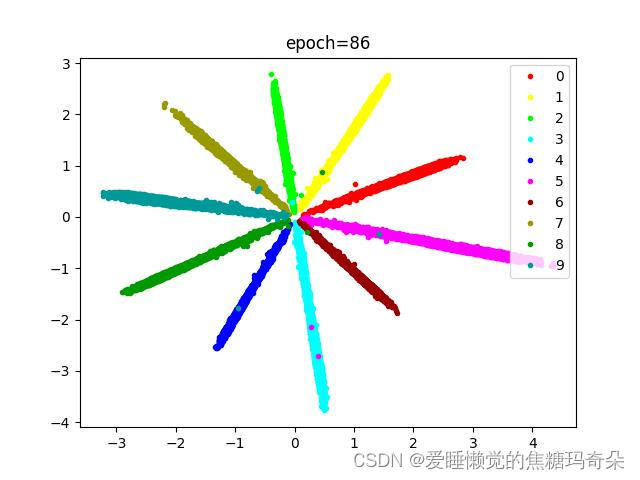
SoftmaxLoss+CenterLoss的效果:
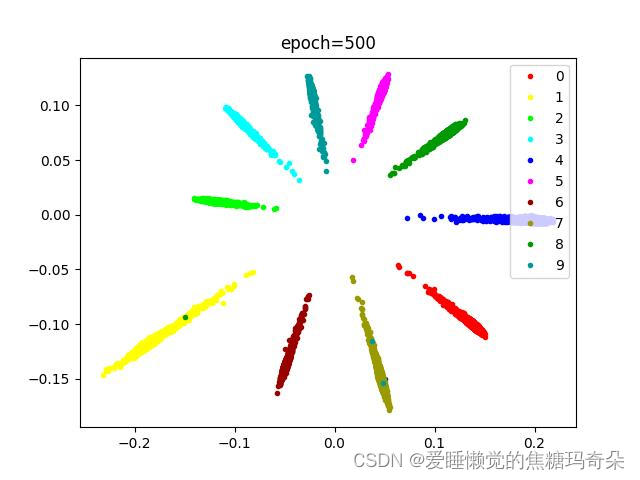























 2万+
2万+

 被折叠的 条评论
为什么被折叠?
被折叠的 条评论
为什么被折叠?








